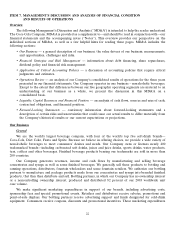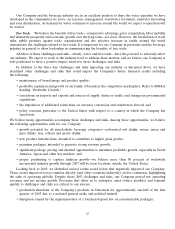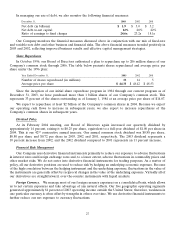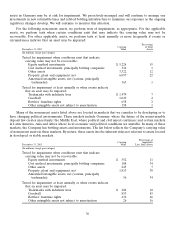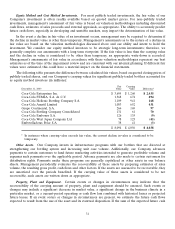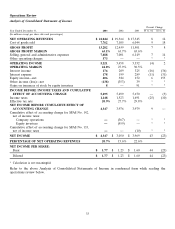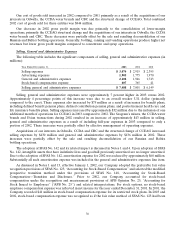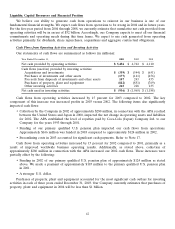Coca Cola 2003 Annual Report Download - page 35
Download and view the complete annual report
Please find page 35 of the 2003 Coca Cola annual report below. You can navigate through the pages in the report by either clicking on the pages listed below, or by using the keyword search tool below to find specific information within the annual report.
flows (undiscounted and without interest charges) is less than the carrying amount, we recognize an impairment
loss. The impairment loss recognized is the amount by which the carrying amount exceeds the fair value.
Goodwill, Trademarks and Other Intangible Assets. Statement of Financial Accounting Standards (‘‘SFAS’’)
No. 142, ‘‘Goodwill and Other Intangible Assets,’’ classifies intangible assets into three categories: (1) intangible
assets with definite lives subject to amortization; (2) intangible assets with indefinite lives not subject to
amortization; and (3) goodwill. For intangible assets with definite lives, tests for impairment must be performed
if conditions exist that indicate the carrying value may not be recoverable. For intangible assets with indefinite
lives and goodwill, tests for impairment must be performed at least annually. Such tests for impairment are also
required for intangible assets recorded by our equity method investees.
Our trademarks and other intangible assets determined to have definite lives are amortized over their
useful lives. In accordance with SFAS No. 142, if conditions exist that indicate the carrying value may not be
recoverable, we review such trademarks and other intangible assets with definite lives for impairment to ensure
they are appropriately valued. Such conditions may include an economic downturn in a market or a change in
the assessment of future operations. Trademarks and other intangible assets determined to have an indefinite
useful life are not amortized. We test such trademarks and other intangible assets with indefinite useful lives for
impairment annually or more frequently if events or circumstances indicate that assets might be impaired.
Goodwill is not amortized. We perform tests for impairment of goodwill annually or more frequently if events or
circumstances indicate it might be impaired. Such tests include comparing the fair value of a reporting unit with
its carrying value, including goodwill. We use a variety of methodologies in conducting these impairment
assessments, including cash flow analysis, estimates of sales proceeds and independent appraisals. Where
applicable, we use an appropriate discount rate, based on the Company’s cost of capital rate or location-specific
economic factors.
Income Taxes
Our income tax expense and related balance sheet amounts involve significant management estimates and
judgments. Judgments regarding realization of deferred tax assets and the ultimate outcome of tax-related
contingencies represent key items involved in the determination of income tax expense and related balance
sheet accounts.
Deferred tax assets represent items to be used as a tax deduction or credit in future tax returns for which we
have already properly recorded the tax benefit in our income statement. Realization of our deferred tax assets
reflects our tax planning strategies. We establish valuation allowances for deferred tax assets that we do not
believe will be realized.
Tax assessments may arise several years after tax returns have been filed. Predicting the outcome of such tax
assessments involves uncertainty; however, we believe that recorded tax liabilities adequately account for our
analysis of probable outcomes.
Refer to Note 15.
Contingencies
Our Company is subject to various claims and contingencies related to legal proceedings. Refer to Note 11.
Due to their nature, such legal proceedings involve inherent uncertainties including, but not limited to, court
rulings, negotiations between affected parties and governmental actions. Management assesses the probability of
loss for such contingencies and accrues a liability and/or discloses the relevant circumstances, as appropriate.
Management believes that any liability to the Company that may arise as a result of currently pending legal
proceedings will not have a material adverse effect on the financial condition of the Company taken as a whole.
32


